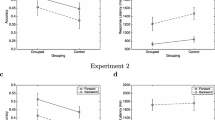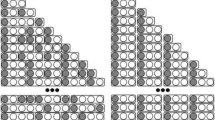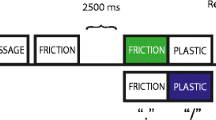Abstract
There are two research paradigms in the area of serial-order memory. One typically uses serial recall (accuracy), and the other comparative judgment (reaction time) for measuring serial-order memory. Spontaneous subgrouping is commonly observed in the recall serial-position function in the form of multiple bowings. However, comparative judgment with a reaction time measure produces a single-bowing function. Researchers adopting these two approaches have opposing views on the form of the structure of serial-order memory with the former favoring a hierarchical, and the latter a unidimensional structure. The present study confirmed the above hypothesized relation between the two measuring procedures and the two different patterns of serial-position functions. It was suggested that a serial recall involves retrieving absolute position information, whereas a comparative judgment involves retrieving relative position information, and that subgrouping serves a facilitating function for the former, but may actually impede the latter process.





Similar content being viewed by others
Notes
Linear as used in this paper does not refer to a mathematical function. It simply means a series or string with only one single structural dimension rather than with a multilevel hierarchical structure.
The stimulus used in a typical absolute identification task is usually a sensory or perceptual stimulus varying along a continuous dimension and the task is usually to uniquely map a magnitude of the stimulus onto a number on a numeric scale. The stimulus used in the present study was a verbal name. In that respect, the absolute identification task used in this study was different from a typical one. However, the verbal name was ordered on an ordinal scale and the task was to uniquely map a name onto a number on an ordinal scale in memory. In that sense, it was an absolute identification task.
References
Anderson, J. R., & Matessa, M. (1997). A production system theory of serial memory. Psychological Review, 104, 728–748.
Baddeley, A. D., & Hitch, G. J. (1993). The recency effect: Implicit learning with explicit retrieval? Memory & Cognition, 21, 146–155.
Banks, W. P. (1977). Encoding and processing of symbolic information in comparative judgments. In G. H. Bower (Ed.), The psychology of learning and motivation (Vol. 11, pp. 101–159). New York: Academic Press.
Banks, W. P., White, H., & Mermelstein, R. (1980). Position effects in comparative judgments of serial order: List structure vs. differential strength. Memory & Cognition, 8, 623–630.
Birnbaum, M. H., & Jou, J. W. (1990). A theory of comparative response time and “difference” judgments. Cognitive Psychology, 22, 184–210.
Botvinick, M. M., & Plaut, D. C. (2006). Short-term memory for serial order: A recurrent neural network model. Psychological Review, 113, 201–233.
Bower, G. H. (1971). Adaptational-level coding of stimuli and serial position effects. In M. H. Appley (Ed.), Adaptation-level theory: A symposium (pp. 175–205). New York: Academic Press.
Brown, G. D., Neath, I., & Chater, N. (2007). A temporal ratio model of memory. Psychological Review, 114, 539–576.
Brown, G. D. A., Preece, T., & Hulme, C. (2000). Oscillator-based memory for serial order. Psychological Review, 107, 127–181.
Crowder, R. G., & Greene, R. L. (2000). Serial learning: Cognition and behavior. In E. Tulving & F. I. M. Craik (Eds.), The Oxford handbook of memory. New York: Oxford University Press.
De Soto, C. B. (1961). The predilection for single ordering. Journal of Abnormal and Social Psychology, 62, 16–23.
Ebenholtz, S. M. (1972). Serial learning and dimensional organization. In G. H. Bower (Ed.), The psychology of learning and motivation (Vol. 5). New York: Academic Press.
Estes, W. K. (1972). An associative basis for coding and organization in memory. In A. W. Melton & E. Martin (Eds.), Coding processes in human memory (pp. 161–190). Washington, DC: Winston.
Estes, W. K. (1985). Levels of association theory. Journal of Experimental Psychology: Learning, Memory, and Cognition, 11, 444–449.
Estes, W. K. (1997). Processes of memory loss, recovery, and distortion. Psychological Review, 104, 148–169.
Farrell, S., & Lelievre, A. (2009). End anchoring in short-term order memory. Journal of Memory and Language, 60, 209–227.
Farrell, S., & Lewandowsky, S. (2002). An endogenous distributed model of ordering in serial recall. Psychonomic Bulletin & Review, 9, 59–79.
Frick, R. W. (1989). Explanations of grouping in immediate ordered recall. Memory & Cognition, 17, 551–562.
Friedman, A. (1978). Memorial comparison without the “mind’s eye”. Journal of Verbal Learning and Verbal Behavior, 17, 427–444.
Gevers, W., Verguts, T., Reynvoet, B., Caessens, B., & Fias, W. (2006). Numbers and space: A computational model of the SNARC effect. Journal of Experimental Psychology: Human Perception and Performance, 32, 32–44.
Glanzer, M., & Cunitz, A. (1966). Two storage mechanisms in free recall. Journal of Verbal Learning and Verbal Behavior, 5, 351–360.
Greene, R. L. (1986). Sources of recency effects in free recall. Psychological Bulletin, 99, 221–228.
Henson, R. N. A. (1998). Short-term memory for serial order: The start-end model. Cognitive Psychology, 36, 73–137.
Hockley, W. E., & Murdock, B. B., Jr. (1987). A decision model for accuracy and response latency in recognition memory. Psychological Review, 94, 341–358.
Holyoak, K. J. (1978). Comparative judgment with numerical reference points. Cognitive Psychology, 10, 203–243.
Holyoak, K. J., & Mah, W. A. (1982). Cognitive reference points in judgements of symbolic magnitude. Cognitive Psychology, 14, 328–352.
Ito, Y., & Hatta, T. (2004). Spatial structure of quantitative representation of numbers: Evidence from the SNARC effect. Memory & Cognition, 32, 662–673.
Jensen, A. R. (1962). Temporal and spatial effects of serial position. American Journal of Psychology, 75, 390–400.
Johnson, G. J. (1991). A distinctiveness model of serial learning. Psychological Review, 98, 204–217.
Jou, J. (1997). Why is the alphabetically middle letter in a multiletter array so hard to determine? Memory processes in linear-order information processing. Journal of Experimental Psychology: Human Perception and Performance, 23, 1743–1763.
Jou, J. (2010). The serial position, distance, and congruity effects of reference-point setting in comparative judgments. The American Journal of Psychology, 123, 127–136.
Jou, J., & Aldridge, J. W. (1999). The memory representation of the alphabetic position and interval information. Journal of Experimental Psychology: Learning, Memory, and Cognition, 25, 680–701.
Kent, C., & Lamberts, K. (2005). An exemplar account of the bow and set-size effects in absolute identification. Journal of Experimental Psychology: Learning, Memory, and Cognition, 31, 289–305.
Klahr, D., Chase, W. G., & Lovelace, E. A. (1983). Structure and process in alphabetic retrieval. Journal of Experimental Psychology: Learning, Memory, and Cognition, 9, 462–477.
Kosslyn, S. M., Murphy, G. L., Bemesderfer, M. E., & Feinstein, K. J. (1977). Category and continuum in mental comparisons. Journal of Experimental Psychology: General, 106, 341–375.
Lee, C. L., & Estes, W. K. (1981). Item and order information in short-term memory: Evidence for multilevel perturbation processes. Journal of Experimental Psychology: Human Learning and Memory, 7, 149–169.
Lewandowsky, S., & Farrell, S. (2008). Short-term memory: New data and a model. In B. H. Ross (Ed.), The psychology of learning and motivation (Vol., 49, pp. 1–48). Boston: Academic Press.
Lewandowsky, S., & Murdock, B. B. (1989). Memory for serial order. Psychological Review, 96, 25–57.
Lewandowsky, S., Nimmo, L. M., & Brown, G. D. A. (2008). When temporal isolation benefits memory or serial order. Journal of Memory and Language, 58, 415–428.
Madigan, S. (1980). The serial position curve in immediate recall. Bulletin of the Psychonomic Society, 15, 335–338.
Maki, R. H. (1981). Categorization and distance effects with spatial linear order. Journal of Experimental Psychology: Human Learning and Memory, 7, 15–32.
Marmurek, H. H., & Johnson, N. F. (1978). Hierarchical organization as a determinant of sequential learning. Memory & Cognition, 6, 240–245.
Marshuetz, C. (2005). Order information in working memory: An integrative review of evidence from brain and behavior. Psychological Bulletin, 131, 323–339.
Martin, E., & Noreen, D. L. (1974). Serial learning: Identification of subjective subsequences. Cognitive Psychology, 6, 421–435.
Maybery, M. T., Parmentier, F. B. R., & Jones, D. M. (2002). Grouping of list items reflected in the timing of recall: Implications for models of serial verbal memory. Journal of Memory and Language, 47, 360–385.
Miller, G. A. (1956/1994). The magical number seven, plus or minus two: Some limits on our capacity for processing information. Psychological Review, 101, 343–353.
Moyer, R. S., & Bayer, R. H. (1976). Mental comparison and the symbolic distance effect. Cognitive Psychology, 8, 228–246.
Neath, I., Brown, G. D. A., McCormack, T., Chater, N., & Freeman, R. (2006). Distinctiveness models of memory and absolute identification: Evidence for local, not global, effects. Quarterly Journal of Experimental Psychology, 59, 121–135.
Ng, H. L. H., & Maybery, M. T. (2002). Grouping in short-term verbal memory: Is position coded temporally? Quarterly Journal of Experimental Psychology, 55A, 391–424.
Ng, H. L. H., & Maybery, M. T. (2005). Grouping in short-term memory: Do oscillators code the positions of items? Journal of Experimental Psychology: Learning, Memory, and Cognition, 31, 175–181.
Nobel, P. A., & Shiffrin, R. M. (2001). Retrieval processes in recognition and cued recall. Journal of Experimental Psychology: Learning, Memory, and Cognition, 27, 384–413.
Page, M. P. A., & Norris, D. (1998). The primacy model: A new model of immediate serial recall. Psychological Review, 105, 761–781.
Petrov, A. A., & Anderson, J. R. (2005). The dynamics of scaling: A memory-based anchor model of category rating and absolute identification. Psychological Review, 112, 383–416.
Pliske, R. M., & Smith, K. H. (1979). Semantic categorization in a linear order problem. Memory & Cognition, 7, 297–302.
Potts, G. R. (1972). Information processing strategies used in the encoding of linear orderings. Journal of Verbal Learning and Verbal Behavior, 11, 727–740.
Potts, G. R. (1974). Incorporating quantitative information into a linear ordering. Memory & Cognition, 2, 533–538.
Reeves, C., Schmauder, A. R., & Morris, R. K. (2000). Stress grouping improves performance on an immediate serial list recall task. Journal of Experimental Psychology: Learning, Memory, and Cognition, 26, 1638–1654.
Ryan, J. (1969). Grouping and short-term memory: Different means and patterns of grouping. Quarterly Journal of Experimental Psychology: Human Experimental Psychology, 21A, 137–147.
Sailor, K. M., & Shoben, E. J. (1993). Effects of category membership on comparative judgment. Journal of Experimental Psychology: Learning, Memory, and Cognition, 19, 1321–1327.
Shoben, E. J., Cech, C. G., Schwanenflugel, P. J., & Sailor, K. M. (1989). Serial position effects in comparative judgments. Journal of Experimental Psychology: Human Perception and Performance, 15, 273–286.
Stewart, N., Brown, G. D. A., & Chater, N. (2005). Absolute identification by relative judgment. Psychological Review, 112, 881–911.
Trabasso, T., & Riley, C. A. (1975). On the construction and use of representation involving linear order. In R. L. Solso (Ed.), Information processing and cognition: The Loyola symposium (pp. 381–409). Hillsdale, NJ: Erlbaum.
Trabasso, T., Riley, C. A., & Wilson, E. G. (1975). The representation of linear order and spatial strategies in reasoning: A developmental study. In R. Falmagne (Ed.), Psychological studies of logic and development (pp. 201–229). Hillsdale, NJ: Erlbaum.
Wikelgren, W. A. (1967). Rehearsal grouping and hierarchical organization of serial position cues in short-term memory. Quarterly Journal of Experimental Psychology, 19, 97–102.
Woocher, F. D., Glass, A. L., & Holyoak, K. J. (1978). Positional discriminability in linear orderings. Memory & Cognition, 6, 165–173.
Woodworth, R. S. (1938). Experimental psychology. New York: Holt.
Acknowledgments
Portion of the research reported in this article was supported by National Institutes of Health MBRS grant 516393. I thank Stephan Lewandowsky and an anonymous reviewer for comments.
Author information
Authors and Affiliations
Corresponding author
Rights and permissions
About this article
Cite this article
Jou, J. Two paradigms of measuring serial-order memory: two different patterns of serial-position functions. Psychological Research 75, 202–213 (2011). https://doi.org/10.1007/s00426-010-0297-0
Received:
Accepted:
Published:
Issue Date:
DOI: https://doi.org/10.1007/s00426-010-0297-0




